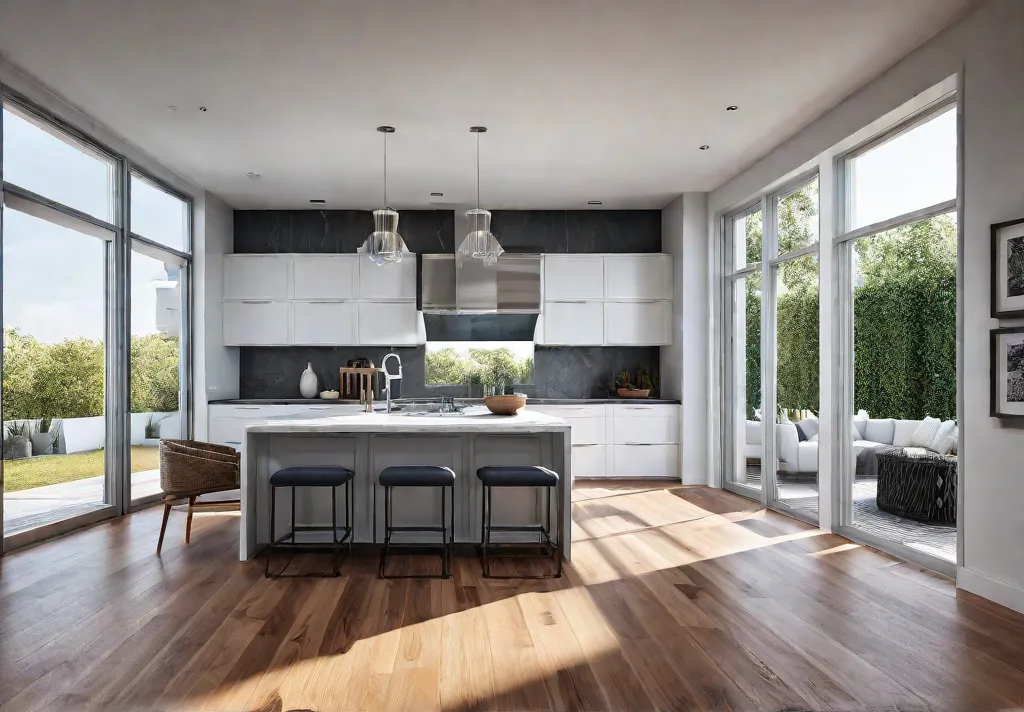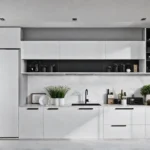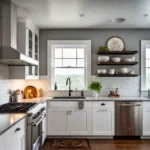Are you tired of constantly mopping up spills and worrying about your kitchen floor’s appearance? As the heart of the home, your kitchen deserves a flooring solution that can withstand the daily hustle and bustle while still looking great. Luckily, plenty of durable, stylish, and comfortable flooring options exist.
This comprehensive guide will explore the pros and cons of various kitchen flooring materials, from classic hardwood to modern vinyl and everything in between. Whether you’re a busy parent, a passionate home chef, or someone who wants a floor that can keep up with their lifestyle, you’ll find the perfect fit for your kitchen.

Get ready to say goodbye to constant cleaning and hello to a functional and fashionable floor. Let’s dive in and find the ideal kitchen flooring that will have you strutting around your space with confidence.
Hardwood Flooring
Hardwood flooring is a timeless choice for kitchens, offering a warm and natural aesthetic. However, its suitability for busy kitchens requires careful consideration. Different hardwood species have varying levels of durability, with oak and maple being more durable than softer woods like pine or cherry.
One of the key drawbacks of hardwood in the kitchen is its susceptibility to water damage. While some engineered hardwood options are more water-resistant than solid hardwood, regular cleaning, and prompt spill cleanup are essential to protect the floors. Hardwood flooring can also be more expensive than other options, so weighing the costs against the desired look and feel is important.
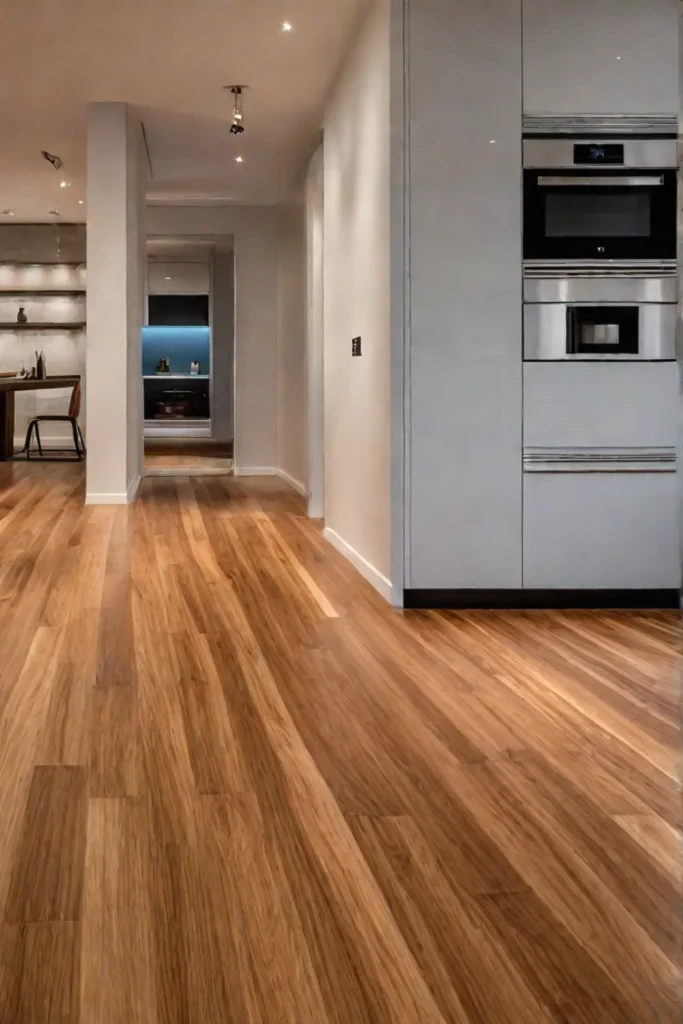
To help protect your hardwood floors, consider using area rugs in high-traffic zones and diligently cleaning up spills immediately. Engineered hardwood can be a more durable and water-resistant alternative to solid hardwood for kitchen floors.
Tile Flooring
Tile is a popular choice for kitchen flooring due to its wide range of styles, durability, and easy maintenance. The tile is highly resistant to water, making it an excellent option for kitchens where spills are common. It’s also scratch-resistant and easy to clean, requiring only regular sweeping and mopping.
When selecting tile for your kitchen, pay close attention to the material’s slip resistance. Some tiles are more slip-resistant than others, which is essential for ensuring your kitchen floor’s safety. Grout maintenance is also crucial, as it can be porous and require sealing to prevent staining and the growth of mold and mildew.
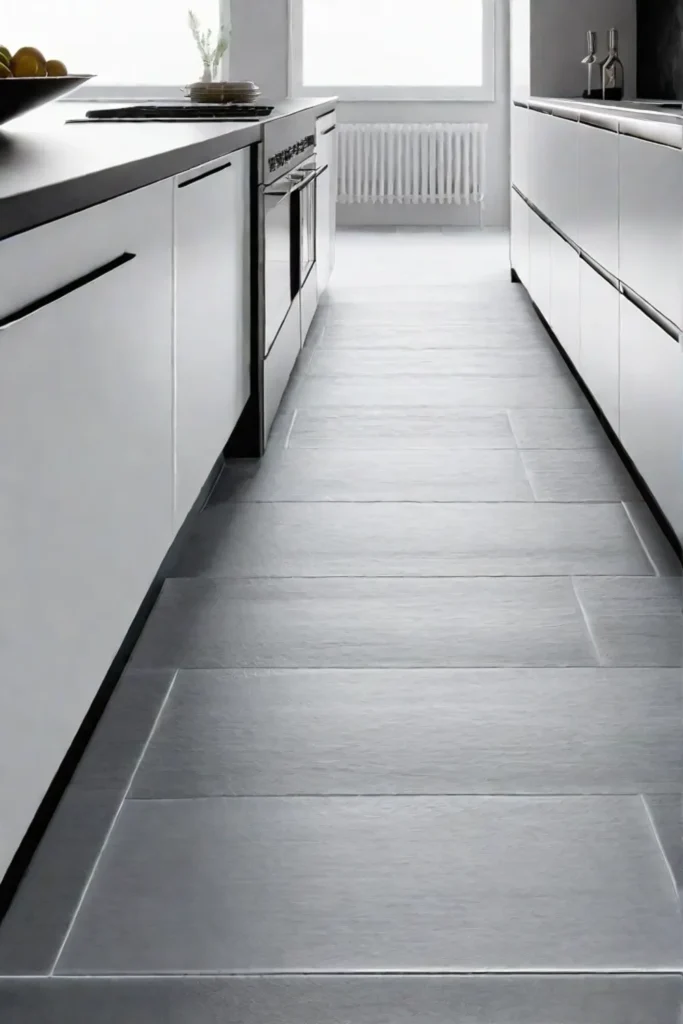
Consider the size, shape, and texture of the tiles for a visually appealing and functional kitchen floor. Large-format tiles can create a sense of spaciousness, while smaller tiles can add visual interest and texture. Smooth tiles are easy to clean, while textured tiles can hide imperfections and provide a bit of grip.
Vinyl Flooring
Vinyl flooring has recently gained popularity as a practical and affordable option for kitchen floors. One of the key benefits of vinyl is its water resistance, making it an ideal choice for kitchens where spills are common. Vinyl is also known for its durability, with many options offering scratch and stain resistance.
Another advantage of vinyl flooring is its ease of installation. Many vinyl options can be installed without adhesive or special tools, making it a convenient choice for DIYers or those who want to avoid the hassle of a traditional flooring installation.
While vinyl is often associated with a hard surface, modern options offer comfort underfoot through cushioned underlayments or textured surfaces. Additionally, advancements in vinyl technology have resulted in more realistic wood and stone-look options, expanding the design possibilities for your kitchen.
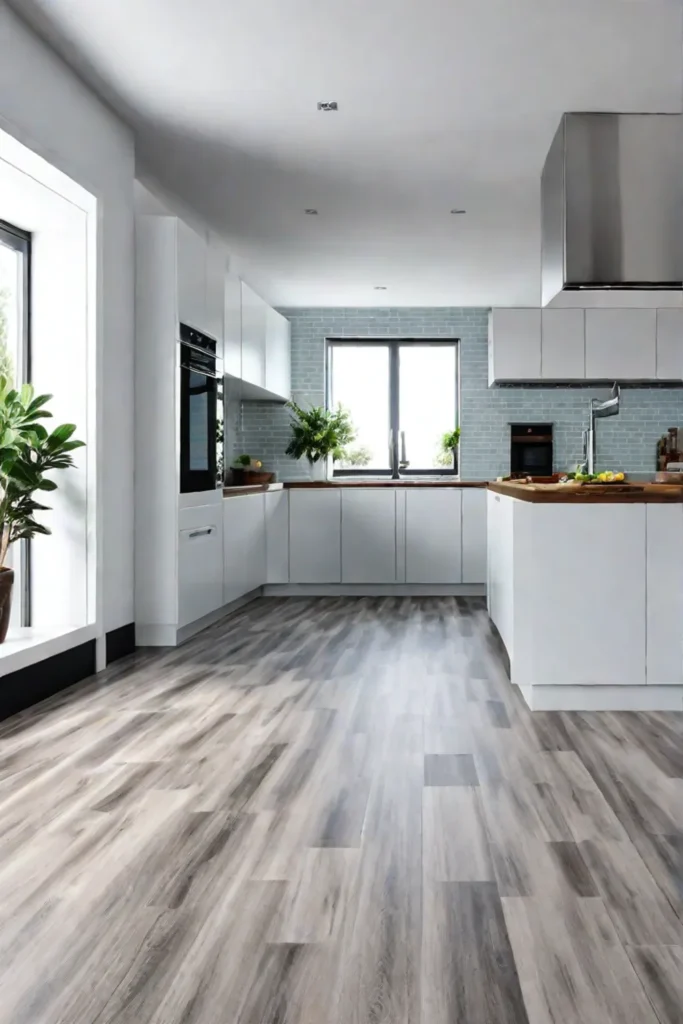
When choosing vinyl for your kitchen, consider the thickness and surface texture to balance durability and comfort. Thicker vinyl is generally more durable, while textured surfaces can provide a bit of cushioning and grip.
Laminate Flooring
Laminate flooring is another budget-friendly option that can mimic the look of more expensive materials, such as hardwood or tile. One of the key benefits of laminate is its durability, as it is resistant to scratches, stains, and fading, making it a practical choice for high-traffic areas like kitchens.
Laminate flooring is also known for its water resistance, which is crucial in a kitchen setting. However, it’s important to note that laminate is not completely waterproof, and it’s best to avoid installing it in areas with constant exposure to water, such as around sinks or dishwashers.
Advancements in printing techniques have allowed laminate manufacturers to create more convincing wood and stone-look options, making laminate a visually appealing choice for homeowners. Proper subfloor preparation and installation are essential when installing laminate in your kitchen to prevent issues like gapping or buckling.

Compared to other kitchen flooring options, laminate is relatively easy to maintain. Regular sweeping or vacuuming and occasional damp mopping are typically all needed to keep it looking its best.
Cork Flooring
If you’re looking for a unique and eco-friendly option, consider cork flooring for your kitchen. Cork is known for its inherent insulation and shock-absorbing properties, providing a comfortable surface underfoot. It’s also water-resistant, making it a suitable choice for kitchens where spills are common.
One of the standout features of cork flooring is its sustainability. Cork is harvested from the bark of cork oak trees, and the trees can be harvested repeatedly without causing any damage. This makes cork a renewable and environmentally friendly material.
To maintain the longevity of cork flooring in a busy kitchen, it’s essential to use area rugs in high-traffic zones and avoid heavy furniture that could dent the surface. Regular cleaning with a soft-bristled broom or microfiber mop is also recommended, as abrasive cleaners can damage the cork.
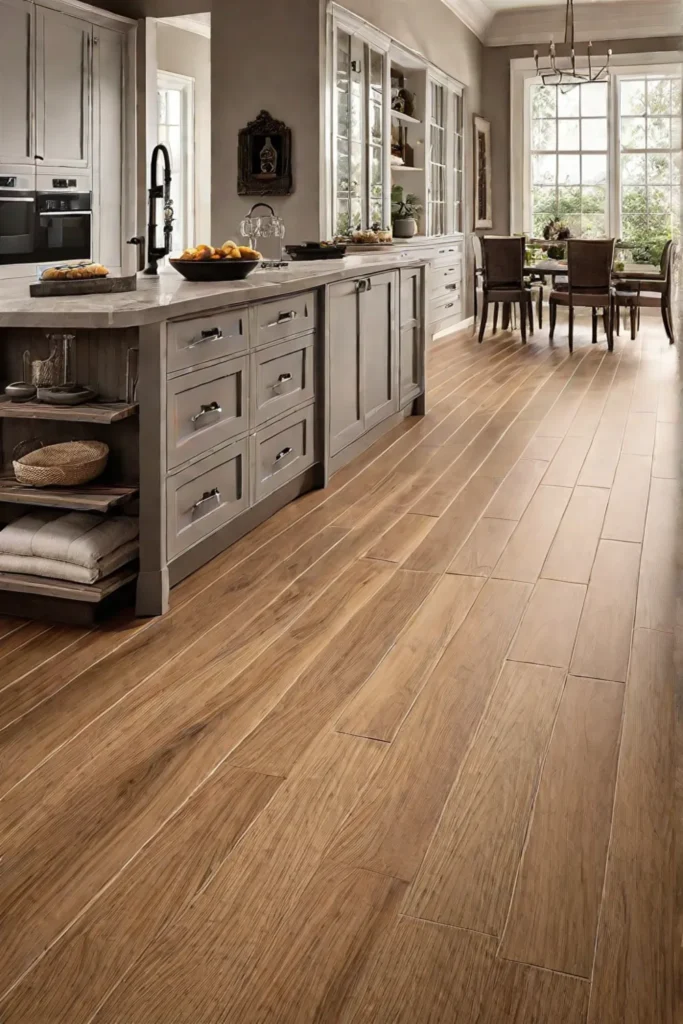
While cork may not be as durable as some other kitchen flooring options, its unique combination of comfort, water resistance, and eco-friendliness makes it a compelling choice for homeowners who value functionality and sustainability.
Bamboo Flooring
Bamboo is another eco-friendly flooring option that has gained popularity in recent years. As a rapidly renewable grass, bamboo is often touted as a more sustainable alternative to traditional hardwood floors. Bamboo flooring is known for its durability, water resistance, and easy maintenance, making it a suitable choice for busy kitchens.
When selecting bamboo flooring for your kitchen, consider the different types available. Solid bamboo is the most durable option but may be more prone to moisture-related issues, such as warping or cupping. Engineered, strand-woven bamboo is more stable and better suited for high-moisture areas like the kitchen.
Proper installation and maintenance are key to ensuring the longevity of bamboo floors in a busy kitchen. Regular cleaning and occasional refinishing can help maintain the appearance and performance of the floors over time.
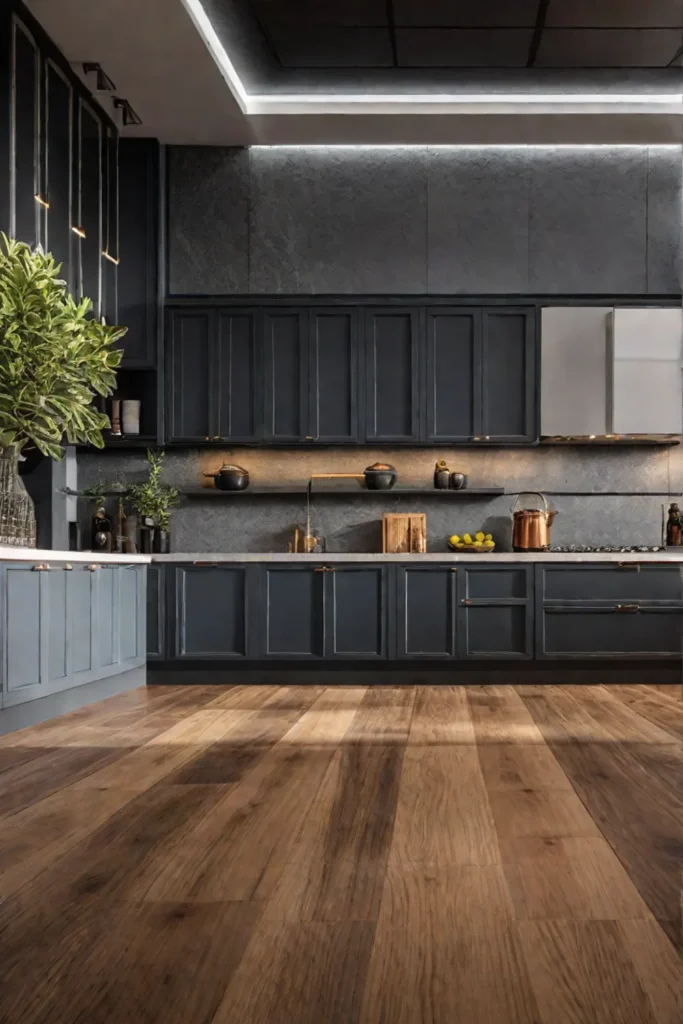
One potential drawback of bamboo in the kitchen is that it may not be as slip-resistant as other flooring options. If safety is a concern, consider incorporating anti-fatigue mats or rugs in high-traffic areas to enhance traction and comfort.
Comfort and Safety Considerations
In addition to durability and aesthetics, the comfort and safety of your kitchen flooring are essential factors to consider. A comfortable and safe kitchen floor can contribute to a more enjoyable cooking experience and reduce the risk of accidents.
Look for flooring materials, such as textured tiles or cork, that provide a slip-resistant surface. This can help prevent slips and falls, especially in high-traffic areas. Additionally, consider the flooring’s cushioning and fatigue-reducing properties. Materials like cork and vinyl can offer a more comfortable surface for extended periods of standing, reducing the strain on your feet and legs.
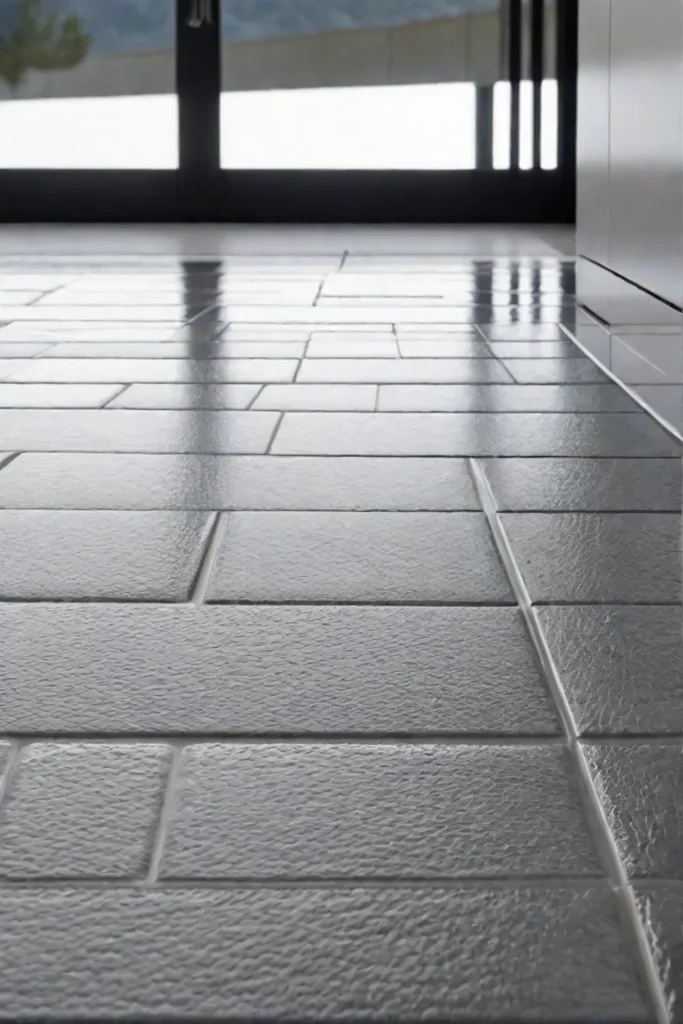
Incorporating anti-fatigue mats or rugs in specific kitchen zones, such as near the sink or stove, can enhance comfort and safety. These additional floor coverings can provide cushioning and traction, making your kitchen a more pleasant and secure workplace.
Maintenance and Longevity
Maintaining the appearance and performance of your kitchen flooring is crucial to ensuring its longevity. Regular cleaning and care are essential for preserving the floor’s look and extending lifespan.
Each flooring material has its own unique cleaning and maintenance requirements. Hardwood floors, for example, require regular dusting and sweeping to prevent scratches, while tile floors need occasional mopping with a mild detergent solution. Vinyl and laminate floors are relatively easy to maintain, often only requiring regular sweeping or vacuuming and occasional damp mopping.
Protecting your kitchen floors from heavy foot traffic, dropped items, and water damage can also help extend their lifespan. Using area rugs or floor mats in high-traffic zones, installing floor protectors on furniture legs, and promptly cleaning up spills can all contribute to the long-term performance of your kitchen flooring.
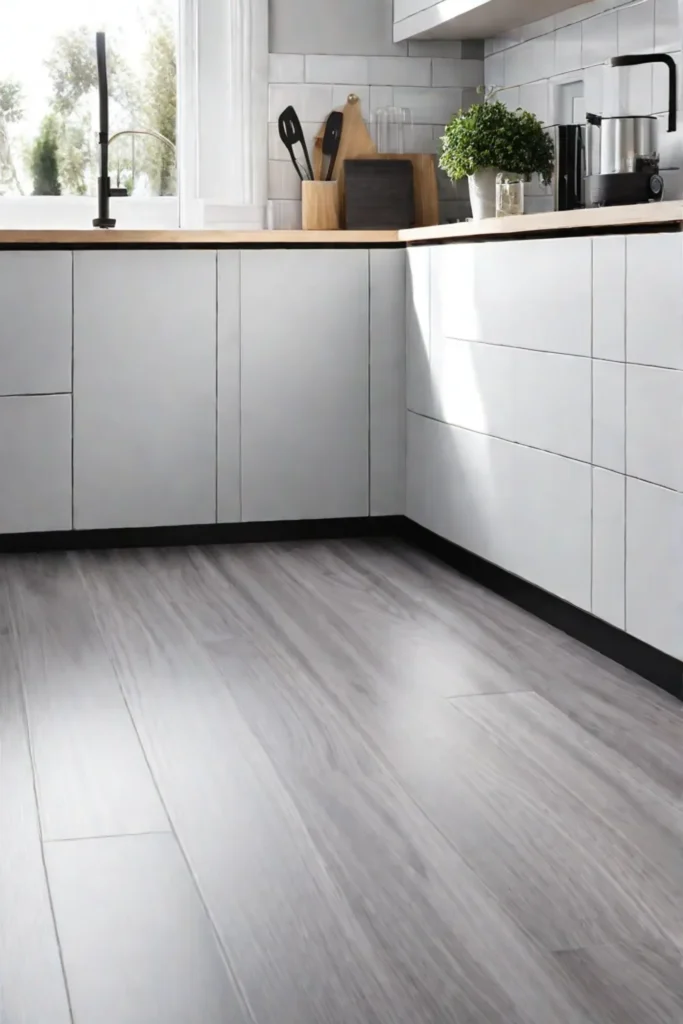
Investing in proper maintenance and protection measures ensures your kitchen floors continue to look great and function well for years to come, regardless of the material you choose.
Conclusion
Selecting the right flooring for your busy kitchen is a crucial decision that requires balancing durability, style, and comfort. From classic hardwood to modern vinyl and eco-friendly cork, there’s a wide range of options, each with unique benefits and considerations.
By carefully evaluating the different flooring materials, their performance characteristics, and your specific needs and preferences, you can find the perfect kitchen floor that will not only withstand the daily hustle and bustle but also enhance your space’s overall aesthetic and functionality.

Remember, the key to a successful kitchen flooring choice lies in balancing practicality and personal style. With the right flooring, you can enjoy a beautiful, comfortable, low-maintenance kitchen for years.
So, what are you waiting for? Start exploring the endless possibilities and find the kitchen flooring that will have you strutting around your space with confidence and pride.
